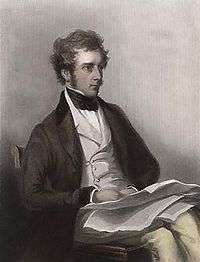Charles Pelham Villiers
| The Right Honourable Charles Pelham Villiers | |
|---|---|
|
| |
| President of the Poor Law Board | |
|
In office 9 July 1859 – 26 June 1866 | |
| Monarch | Victoria |
| Prime Minister |
The Viscount Palmerston The Earl Russell |
| Preceded by | Thomas Milner Gibson |
| Succeeded by | Gathorne Hardy |
| Personal details | |
| Born | 3 January 1802 |
| Died | 16 January 1898 (aged 96) |
| Nationality | British |
| Political party |
Liberal Liberal Unionist |
| Spouse(s) | Unmarried |
| Alma mater | St John's College, Cambridge |
Charles Pelham Villiers (3 January 1802 – 16 January 1898) was a British lawyer and politician from the Villiers family who sat in the House of Commons from 1835 to 1898, making him the longest-serving Member of Parliament (MP). Pelham Villiers also holds the distinction of the oldest candidate to win a parliamentary seat, at the age of 93.
Background and education
Villiers was the son of the Hon. George Villiers and the Hon. Theresa, daughter of John Parker, 1st Baron Boringdon. He was grandson of Thomas Villiers, 1st Earl of Clarendon and brother of George Villiers, 4th Earl of Clarendon. He was educated at East India Company College and St John's College, Cambridge,[1] becoming a barrister at Lincoln's Inn in 1827. He was raised to the rank of an Earl's son in 1839 and thus entitled to be styled the Honourable Charles Pelham Villiers.
Political career
Villiers held Benthamite political views, and enjoyed a long career in public service and Parliament. In 1832, he was a Poor Law Commissioner, and from 1833 to 1852 was examiner of witnesses in the Court of Chancery.
Villiers was elected as a Liberal Member of Parliament for Wolverhampton in 1835. In 1837, 1838, 1839, 1840, 1841, 1842, 1843, 1844, 1845 he launched parliamentary debates in attempts to repeal the Corn Laws. In 1838, he spoke to over 5000 "working class men" in Manchester and told them that the presence of so large an audience gave him the proof that "the working class man was with him". Villiers was unsuccessful in his attempts, but in 1840 sat on the Committee on Import Duties that provided much of the evidence that pressured Robert Peel into his sliding scale concession in 1842. The bluebook produced by the Committee on Import Duties was published in pamphlet form and distributed across the country by the Anti Corn Law League, it was reprinted in America and quoted by all leading newspapers of the day, the Spectator published it in abridged form. In February 1842 Villiers was called by Monckton Milne MP the "solitary Robinson Crusoe standing on the barren rock of Corn Law repeal". In 1842, the majority in favour of retaining the Corn Laws had been 303, at the vote on Villiers motion in June 1845 it was down to 132. After repeal in 1846, the press said of Villiers that he was "the most persevering and undaunted supporter of those principles within the house". David Ricardo, Chairman of the Free Traders in London wished to raise money to give to Villiers in recognition of his work, Villiers declined this.
Villiers was a corresponding member of the British and Foreign Anti-Slavery Society and he attended the World Anti-Slavery Convention in London in 1840.[2]
In 1847 he was also returned for Lancashire South but elected to sit for his former constituency; his election in Lancashire South was unsolicited but an honour conferred by the people there to express their gratitude for his goodwork with the repeal of the Corn Laws. Villiers was sworn of the Privy Council in 1853[3] and served under Lord Aberdeen and Lord Palmerston as Judge Advocate General from 1852 to 1858. In 1853 the Times observed that "it was Mr Charles Villiers who practically originated the Free Trade movement". He served under Palmerston and Lord Russell as President of the Poor Law Board (with a seat in the cabinet) from 1859 to 1866.
Villier was offered a peerage in June 1885, but declined.[4] His Wolverhampton constituency was divided under the Redistribution of Seats Act 1885 and he was then elected for Wolverhampton South, switching to the Liberal Unionist party in 1886. He was the Father of the House of Commons from 1890 until his death in 1898. However, the last time he attended Parliament was in 1895. During his time in Parliament he worked towards free trade and opposed the Corn Laws and home rule for Ireland. He is noted as being the voice in parliament of the free trade movement before the election of Richard Cobden and John Bright. Villiers was the last remaining MP to have served under King William IV.
Personal life
Villiers died unmarried in January 1898, aged 96. He is buried at Kensal Green Cemetery.[5] A statue of him stands in West Park in Wolverhampton.
References
- ↑ "Villiers, Charles Pelham (VLRS820CP)". A Cambridge Alumni Database. University of Cambridge.
- ↑ BFASS Convention 1840, List of delegates, Retrieved 15 January 2016
- ↑ The London Gazette: no. 21409. p. 330. 8 February 1853.
- ↑ Debretts Guide to the House of Commons 1886
- ↑ Paths of Glory. Friends of Kensal Green Cemetery. 1997. p. 102.
External links
| Wikisource has original works written by or about: Charles Pelham Villiers |
- Hansard 1803–2005: contributions in Parliament by Charles Pelham Villiers
- Wolverhampton history: Charles Pelham Villiers
- Portraits of Charles Pelham Villiers at the National Portrait Gallery, London

- Charles Pelham Villiers at the National Registry of Archives
| Parliament of the United Kingdom | ||
|---|---|---|
| Preceded by William Wolryche-Whitmore Richard Fryer |
Member of Parliament for Wolverhampton 1835–1885 With: Thomas Thornley, 1835–1859 Sir Richard Bethell, 1859–1861 Thomas Matthias Weguelin, 1861–1880 Henry Fowler, 1880–1885 |
Constituency divided see: Wolverhampton East Wolverhampton South Wolverhampton West |
| New constituency before: Wolverhampton |
Member of Parliament for Wolverhampton South 1885–1898 |
Succeeded by John Lloyd Gibbons |
| Preceded by Christopher Talbot |
Father of the House 1890–1898 |
Succeeded by Sir John Mowbray, Bt |
| Preceded by James Patrick Mahon |
Oldest Member of Parliament 1885–1887 |
Succeeded by James Patrick Mahon |
| Preceded by James Patrick Mahon |
Oldest Member of Parliament 1891–1898 |
Succeeded by Sir John Mowbray, Bt |
| Political offices | ||
| Preceded by George Bankes |
Judge Advocate General 1852–1858 |
Succeeded by John Mowbray |
| Preceded by Thomas Milner Gibson |
President of the Poor Law Board 1859–1866 |
Succeeded by Gathorne Hardy |

